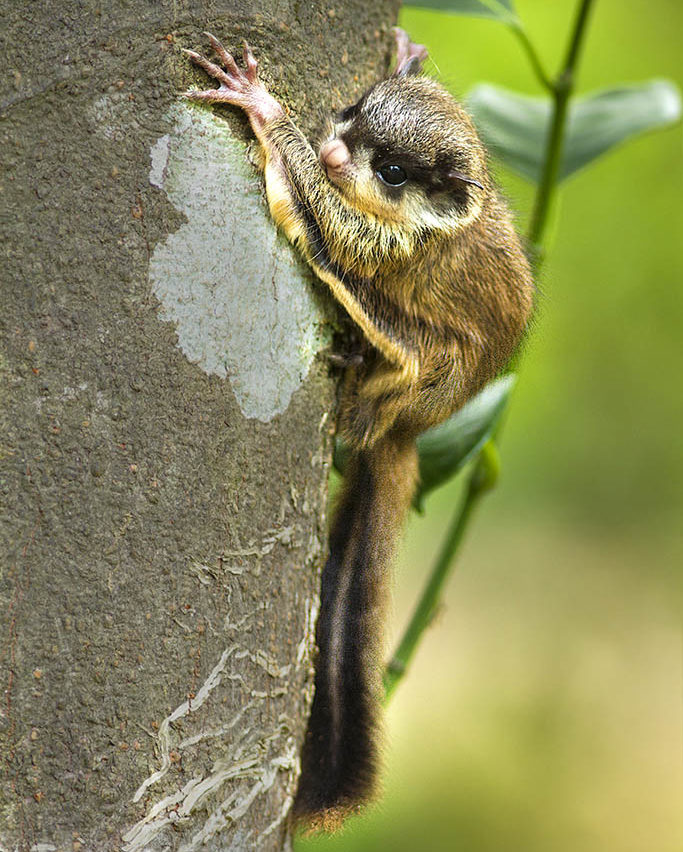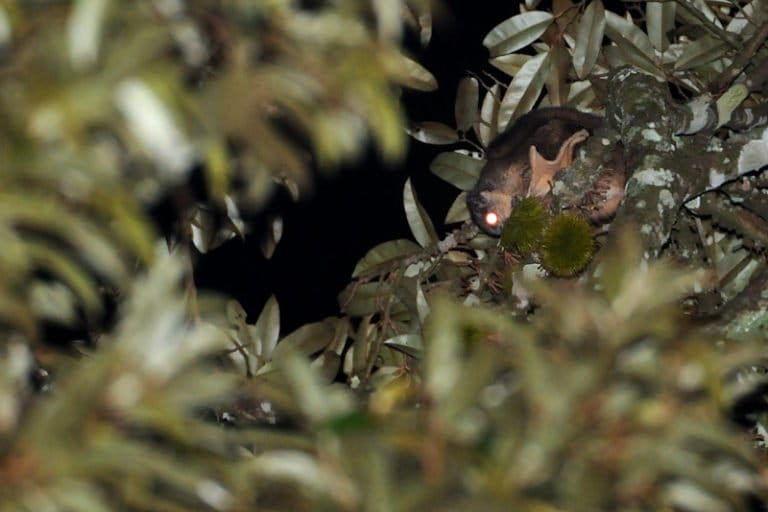- Originally thought to be extinct, the Travancore flying squirrel of the Western Ghats is currently one of the smallest flying squirrel species in South Asia.
- Travancore flying squirrels have an average lifespan of three and a half years and about two offspring per litter, though their rarity in the wild makes their mating habits tough to study.
- The species is dwindling in numbers due to threats from illegal logging and local human settlements, as well as cashew and arecanut farmers whose crops are often consumed by the squirrel.
Found among the lush forests of Kerala and Tamil Nadu with a minor distribution in southern Karnataka and Goa, the Petinomys fuscocapillus, or the Travancore flying squirrel, is among the rarest squirrel species in southern India.
The fascinating squirrel is named after the Kingdom of Travancore, an Indian kingdom in present-day Kerala and southern Tamil Nadu, which existed between 870 CE and 1949 CE.
The species was thought to be extinct until it was rediscovered in 1989 in a Kerala coconut field and parts of central and southern Sri Lanka. With nearly 17 species of flying squirrels, South Asia is home to a large variety of flying squirrels, many of which are in India; the Travancore flying squirrel, for one, however, has faced a number of threats over the past few years.
Among the smallest flying squirrels in India
With a 32-centimetre body length and tail lengths as short as 25 centimetres, the squirrel is much smaller than the Petaurista phillippensis, commonly called the Indian giant flying squirrel, which is found around Gujarat, with a body length of 43 centimetres and a tail nearly twice as long.
The Travancore flying squirrel has soft, reddish-brown dorsal fur resembling the color of polished copper, along with jet black whiskers and a greyish stomach. It has dark patches of fur around its eyes and above its snout-like nose, and the edges of its tail are shaped like vanes of a feather.

The Petinomys fuscocapillus fuscocapillus subspecies, in particular, has been found in both wet regions like the Malabar coast and the Nilgiris, as well as drier regions like the Annamalai and Meghamalai areas in Tamil Nadu. The species is not found anywhere else in India.
According to a 2011 study published by Honnavalli Kumara of the Salim Ali Centre for Ornithology and Natural History (SACON) and Ramamoorthy Suganthasakthivel of the Kerala Forest Research Institute (KFRI), the “restricted distribution of [the Travancore flying squirrel] is mainly due to its preference to a particular narrow environmental niche.”
Given its tropical and terrestrial endemism, the squirrel has been found at elevations as low as 500 metres and as high as 2000 metres. The squirrel is endothermic, which allows it to survive across a range of ambient temperatures. It has an average mass of around 0.79 kilograms and its narrow and stout ears are between 27 and 30 millimetres long, with a small cluster of back fur around their base.
The flight of the squirrel
Travancore flying squirrels have an average of two offspring per litter and a lifespan of no greater than three and a half years. The species is largely arboreal, with female squirrels raising and feeding their young within hollows of tree trunks, which are lined with herbs and grasses. Meanwhile, male squirrels spend their days mainly in isolation within their tree dwellings.
A technical report on the status and distribution of the Travancore and brown flying squirrels in the Western Ghats, submitted in 2015 by researcher Nandini Rajamani notes that the choice of habitats of the Travancore flying squirrel might be influenced by larger trees, which are conducive to larger trunk cavities and allow squirrels to glide more efficiently.
Travancore flying squirrels emerge from their abodes to gather their staple diet of seeds, nuts, grains, leaves and fruit, which are consumed by young and old squirrels alike. Occasionally, the species will eat insects and small gastropods, though this is often out of hunger and not the squirrel’s usual choice.

As their name suggests, the species is a type of flying squirrel, and can thereby glide from tree to tree by means of a patagium — an interfemoral membrane stretching between the squirrel’s hind limbs that act as a wing. “When the squirrels flatten their bodies and spread their limbs, the membrane expands, allowing them to glide,” explains P.S. Sumashini, a research fellow at the Ashoka Trust for Research in Ecology and the Environment, in an article for the Wildlife Conservation Society. “Otherwise, it is folded in.”
Flying squirrels can change direction during flight by using cartilaginous bones within their wrists to steer. These squirrels can glide at high speeds, but their long tails act as airfoils, stabilizing their flight while landing on all four limbs allows flying squirrels to evenly absorb the impact of their target trees without injuring themselves.
Habitat destruction, hunting threaten the Travancore flying squirrel
Though the species was designated as one of Least Concern by the International Union for the Conservation of Nature (IUCN) Red List in 2016, it has faced habitat loss in recent years due to deforestation and other human interferences.
Small-scale logging is extremely common in Kerala and Tamil Nadu, according to a 2017 report by the ecological organisation NEPCon. Combined with the expansion of agricultural land and human settlements, this has posed a notable risk to the dwindling Travancore flying squirrel population.
Some of the local communities also hunt the squirrels for food, according to the aforementioned 2011 study by Kumara and Suganthasakthivel, despite it being protected by Schedule I of the Indian Wildlife (Protection) Act of 1972. Otherwise, however, the Travancore flying squirrel has no known natural predators and is largely considered a crop pest by farmers.

SACON’s Kumara separately expressed his finding that Travancore flying squirrels often predate on areca and cashew nuts and therefore are hunted in Indian croplands.
“This is an important and alarming piece of information, which needs to be considered for its conservation,” he told Mongabay-India. Kumara also theorised that such hunting has played a large role in the squirrel’s low encounter rate in the wild, which has meant limited data available on the species.
Additionally, ecosystem stresses like air and water pollution have also resulted in premature deaths of Travancore flying squirrels. The city of Thrissur has among the worst rates of pollution in Kerala in terms of particulate matter up to 10 micrometres, and this smog has affected several species in the Sholayar Reserve Forest.
Forests in South Asia overwhelmingly comprise dipterocarp trees, a family of 16 genera that are tall, diverse and thickly packed. As such, these trees have been favorable to lumberjacks and woodcutters both domestically and internationally, who have exploited Kerala and Tamil Nadu’s forests for timber. Given the arboreality of Travancore flying squirrels, the illegal logging trade has disproportionately affected them.
Editor’s note: The reference to where the species is found in Sri Lanka was updated on May 21. The photo credit for the banner image has also been corrected.
Banner image: Travancore flying squirrel. Photo by Ranil Nanayakkara.
